Ecosystem Multifunctionality Regulated by Soil Microbial Activity and Indicator Taxa Versus Biodiversity for Industrial Solar Facilities on the Qinghai–Tibet Plateau
Abstract
1. Introduction
2. Materials and Methods
2.1. Site Description, Experimental Design and Soil Sampling
2.2. Environmental Characteristic Measurements
2.3. DNA Extraction and Sequence Processing
2.4. Biodiversity Measurement
2.5. Microbial Indicator Taxa and Microbial Activity Measurement
2.6. Ecosystem Functions and Multifunctionality
2.7. Statistical Analyses
3. Results
3.1. Annual Effect Size of Solar Facilities on Ecosystem Multifunctionality
3.2. Responses of Diversity to Solar Facilities
3.3. Effects of Microbial Taxa on Ecosystem Multifunctionality
3.4. Responses of Soil Microbial Activity to Solar Facilities
3.5. Primary Driving Factors of Ecosystem Multifunctionality
3.6. Regulatory Paths of Eosystem Multifunctionality
4. Discussion
4.1. Solar Facilities Enhance Individual Ecosystem Function and Ecosystem Multifunctionality
4.2. Primary Driving Factors of Ecosystem Multifunctionality
4.3. Distinct Regulatory Paths of Ecosystem Multifunctionality
4.4. Research Implications
5. Conclusions
Supplementary Materials
Author Contributions
Funding
Institutional Review Board Statement
Informed Consent Statement
Data Availability Statement
Conflicts of Interest
References
- Yue, S.; Guo, M.; Zou, P.; Wu, W.; Zhou, X. Effects of photovoltaic panels on soil temperature and moisture in desert areas. Environ. Sci. Pollut. Res. 2021, 28, 17506–17518. [Google Scholar] [CrossRef]
- Osaki, K. US Energy Information Administration (EIA): 2019 Edition US Annual Energy Outlook report (AEO2019). Haikan Gijutsu 2019, 61, 32–43. [Google Scholar]
- Armstrong, A.; Ostle, N.J.; Whitaker, J. Solar park microclimate and vegetation management effects on grassland carbon cycling. Environ. Res. Lett. 2016, 11, 74016. [Google Scholar] [CrossRef]
- Wang, S.; Wang, X.; Han, X.; Deng, Y. Higher precipitation strengthens the microbial interactions in semi-arid grassland soils. Glob. Ecol. Biogeogr. 2018, 27, 570–580. [Google Scholar] [CrossRef]
- Lambert, Q.; Bischoff, A.; Cueff, S.; Cluchier, A.; Gros, R. Effects of solar park construction and solar panels on soil quality, microclimate, CO2 effluxes, and vegetation under a Mediterranean climate. Land Degrad. Dev. 2021, 32, 5190–5202. [Google Scholar] [CrossRef]
- Grodsky, S.M.; Hernandez, R.R. Reduced ecosystem services of desert plants from ground-mounted solar energy development. Nat. Sustain. 2020, 3, 1036–1043. [Google Scholar] [CrossRef]
- Moore O’Leary, K.A.; Hernandez, R.R.; Johnston, D.S.; Abella, S.R.; Tanner, K.E.; Swanson, A.C.; Kreitler, J.; Lovich, J.E. Sustainability of utility-scale solar energy-critical ecological concepts. Front. Ecol. Environ. 2017, 15, 385–394. [Google Scholar] [CrossRef]
- Hernandez, R.R.; Hoffacker, M.K.; Murphy-Mariscal, M.L.; Wu, G.C.; Allen, M.F. Solar energy development impacts on land cover change and protected areas. Proc. Natl. Acad. Sci. USA 2015, 112, 13579–13584. [Google Scholar] [CrossRef]
- Byrnes, J.E.; Gamfeldt, L.; Isbell, F.; Lefcheck, J.S.; Griffin, J.N.; Hector, A.; Cardinale, B.J.; Hooper, D.U.; Dee, L.E.; Emmett Duffy, J. Investigating the relationship between biodiversity and ecosystem multifunctionality: Challenges and solutions. Methods Ecol. Evol. 2014, 5, 111–124. [Google Scholar] [CrossRef]
- Wagg, C.; Bender, S.F.; Widmer, F.; Van Der Heijden, M.G. Soil biodiversity and soil community composition determine ecosystem multifunctionality. Proc. Natl. Acad. Sci. USA 2014, 111, 5266–5270. [Google Scholar] [CrossRef]
- Delgado-Baquerizo, M.; Maestre, F.T.; Reich, P.B.; Jeffries, T.C.; Gaitan, J.J.; Encinar, D.; Berdugo, M.; Campbell, C.D.; Singh, B.K. Microbial diversity drives multifunctionality in terrestrial ecosystems. Nat. Commun. 2016, 7, 10541. [Google Scholar] [CrossRef] [PubMed]
- Louca, S.; Polz, M.F.; Mazel, F.; Albright, M.B.; Huber, J.A.; O Connor, M.I.; Ackermann, M.; Hahn, A.S.; Srivastava, D.S.; Crowe, S.A. Function and functional redundancy in microbial systems. Nat. Ecol. Evol. 2018, 2, 936–943. [Google Scholar] [CrossRef]
- Roger, F.; Bertilsson, S.; Langenheder, S.; Osman, O.A.; Gamfeldt, L. Effects of multiple dimensions of bacterial diversity on functioning, stability and multifunctionality. Ecology 2016, 97, 2716–2728. [Google Scholar] [CrossRef] [PubMed]
- Chen, Q.; Ding, J.; Zhu, D.; Hu, H.; Delgado-Baquerizo, M.; Ma, Y.; He, J.; Zhu, Y. Rare microbial taxa as the major drivers of ecosystem multifunctionality in long-term fertilized soils. Soil Biol. Biochem. 2020, 141, 107686. [Google Scholar] [CrossRef]
- Zheng, H.; Yang, T.; Bao, Y.; He, P.; Yang, K.; Mei, X.; Wei, Z.; Xu, Y.; Shen, Q.; Banerjee, S. Network analysis and subsequent culturing reveal keystone taxa involved in microbial litter decomposition dynamics. Soil Biol. Biochem. 2021, 157, 108230. [Google Scholar] [CrossRef]
- Hartman, K.; van der Heijden, M.G.; Wittwer, R.A.; Banerjee, S.; Walser, J.; Schlaeppi, K. Cropping practices manipulate abundance patterns of root and soil microbiome members paving the way to smart farming. Microbiome 2018, 6, 74. [Google Scholar] [CrossRef]
- Azarbad, H.; Tremblay, J.; Bainard, L.D.; Yergeau, E. Relative and quantitative rhizosphere microbiome profiling results in distinct abundance patterns. Front. Microbiol. 2022, 12, 798023. [Google Scholar] [CrossRef]
- Liu, B.; Bei, Q.; Wang, X.; Liu, Q.; Hu, S.; Lin, Z.; Zhang, Y.; Lin, X.; Jin, H.; Hu, T. Microbial metabolic efficiency and community stability in high and low fertility soils following wheat residue addition. Appl. Soil Ecol. 2021, 159, 103848. [Google Scholar] [CrossRef]
- Tao, F.; Huang, Y.; Hungate, B.A.; Manzoni, S.; Frey, S.D.; Schmidt, M.W.; Reichstein, M.; Carvalhais, N.; Ciais, P.; Jiang, L. Microbial carbon use efficiency promotes global soil carbon storage. Nature 2023, 618, 981–985. [Google Scholar] [CrossRef]
- Liu, Y.; Ding, C.; Su, D.; Wang, T.; Wang, T. Solar park promoted microbial nitrogen and phosphorus cycle potentials but reduced soil prokaryotic diversity and network stability in alpine desert ecosystem. Front. Microbiol. 2022, 13, 976335. [Google Scholar] [CrossRef]
- Liu, Y.; Zhang, R.Q.; Huang, Z.; Cheng, Z.; López Vicente, M.; Ma, X.R.; Wu, G.L. Solar photovoltaic panels significantly promote vegetation recovery by modifying the soil surface microhabitats in an arid sandy ecosystem. Land Degrad. Dev. 2019, 30, 2177–2186. [Google Scholar] [CrossRef]
- Mckenzie, N.; Coughlan, K.; Cresswell, H. Soil Physical Measurement and Interpretation for Land Evaluation; Csiro Publishing: Clayton, Australia, 2002; ISBN 0643067671. [Google Scholar]
- Bolyen, E.; Rideout, J.R.; Dillon, M.R.; Bokulich, N.A.; Abnet, C.C.; Al-Ghalith, G.A.; Alexander, H.; Alm, E.J.; Arumugam, M.; Asnicar, F. Reproducible, interactive, scalable and extensible microbiome data science using QIIME 2. Nat. Biotechnol. 2019, 37, 852–857. [Google Scholar] [CrossRef]
- Callahan, B.J.; Mcmurdie, P.J.; Rosen, M.J.; Han, A.W.; Johnson, A.J.A.; Holmes, S.P. DADA2: High-resolution sample inference from Illumina amplicon data. Nat. Methods 2016, 13, 581–583. [Google Scholar] [CrossRef] [PubMed]
- Douglas, G.M.; Maffei, V.J.; Zaneveld, J.R.; Yurgel, S.N.; Brown, J.R.; Taylor, C.M.; Huttenhower, C.; Langille, M.G. PICRUSt2 for prediction of metagenome functions. Nat. Biotechnol. 2020, 38, 685–688. [Google Scholar] [CrossRef] [PubMed]
- Laliberté, E.; Legendre, P. A distance-based framework for measuring functional diversity from multiple traits. Ecology 2010, 91, 299–305. [Google Scholar] [CrossRef]
- Dufrêne, M.; Legendre, P. Species assemblages and indicator species: The need for a flexible asymmetrical approach. Ecol. Monogr. 1997, 67, 345–366. [Google Scholar] [CrossRef]
- Deng, Y.; Jiang, Y.; Yang, Y.; He, Z.; Luo, F.; Zhou, J. Molecular ecological network analyses. BMC Bioinform. 2012, 13, 113. [Google Scholar] [CrossRef]
- Jiao, S.; Lu, Y. Abundant fungi adapt to broader environmental gradients than rare fungi in agricultural fields. Glob. Change Biol. 2020, 26, 4506–4520. [Google Scholar] [CrossRef]
- Wan, W.; Grossart, H.; He, D.; Yuan, W.; Yang, Y. Stronger environmental adaptation of rare rather than abundant bacterioplankton in response to dredging in eutrophic Lake Nanhu (Wuhan, China). Water Res. 2021, 190, 116751. [Google Scholar] [CrossRef]
- Jian, C.; Luukkonen, P.; Yki-Järvinen, H.; Salonen, A.; Korpela, K. Quantitative PCR provides a simple and accessible method for quantitative microbiota profiling. PLoS ONE 2020, 15, e227285. [Google Scholar] [CrossRef]
- De–Polli, H.; Costantini, A.; Romaniuk, R.; Pimentel, M.S. Chloroform fumigation–extraction labile C pool (microbial biomass C “plus”) shows high correlation to microbial biomass C in Argentinian and Brazilian soils. Cienc. Del Suelo 2007, 25, 15–22. [Google Scholar]
- Yan, T.; Yang, L.; Campbell, C.D. Microbial biomass and metabolic quotient of soils under different land use in the Three Gorges Reservoir area. Geoderma 2003, 115, 129–138. [Google Scholar] [CrossRef]
- Manning, P.; Van Der Plas, F.; Soliveres, S.; Allan, E.; Maestre, F.T.; Mace, G.; Whittingham, M.J.; Fischer, M. Redefining ecosystem multifunctionality. Nat. Ecol. Evol. 2018, 2, 427–436. [Google Scholar] [CrossRef] [PubMed]
- Maestre, F.T.; Quero, J.L.; Gotelli, N.J.; Escudero, A.; Ochoa, V.; Delgado-Baquerizo, M.; García-Gómez, M.; Bowker, M.A.; Soliveres, S.; Escolar, C. Plant species richness and ecosystem multifunctionality in global drylands. Science 2012, 335, 214–218. [Google Scholar] [CrossRef]
- Soliveres, S.; Van Der Plas, F.; Manning, P.; Prati, D.; Gossner, M.M.; Renner, S.C.; Alt, F.; Arndt, H.; Baumgartner, V.; Binkenstein, J. Biodiversity at multiple trophic levels is needed for ecosystem multifunctionality. Nature 2016, 536, 456–459. [Google Scholar] [CrossRef]
- Lefcheck, J.S. piecewiseSEM: Piecewise structural equation modelling in r for ecology, evolution, and systematics. Methods Ecol. Evol. 2016, 7, 573–579. [Google Scholar] [CrossRef]
- Baert, J.M.; Eisenhauer, N.; Janssen, C.R.; De Laender, F. Biodiversity effects on ecosystem functioning respond unimodally to environmental stress. Ecol. Lett. 2018, 21, 1191–1199. [Google Scholar] [CrossRef]
- Steudel, B.; Hector, A.; Friedl, T.; Löfke, C.; Lorenz, M.; Wesche, M.; Kessler, M. Biodiversity effects on ecosystem functioning change along environmental stress gradients. Ecol. Lett. 2012, 15, 1397–1405. [Google Scholar] [CrossRef]
- Basile–Doelsch, I.; Balesdent, J.; Pellerin, S. Reviews and syntheses: The mechanisms underlying carbon storage in soil. Biogeosciences 2020, 17, 5223–5242. [Google Scholar] [CrossRef]
- Chen, J.I.; Elsgaard, L.; van Groenigen, K.J.; Olesen, J.E.; Liang, Z.; Jiang, Y.U.; Lærke, P.E.; Zhang, Y.; Luo, Y.; Hungate, B.A. Soil carbon loss with warming: New evidence from carbon-degrading enzymes. Glob. Change Biol. 2020, 26, 1944–1952. [Google Scholar] [CrossRef]
- Zwetsloot, M.J.; van Leeuwen, J.; Hemerik, L.; Martens, H.; Simo Josa, I.; Van de Broek, M.; Debeljak, M.; Rutgers, M.; Sandén, T.; Wall, D.P. Soil multifunctionality: Synergies and trade-offs across European climatic zones and land uses. Eur. J. Soil Sci. 2021, 72, 1640–1654. [Google Scholar] [CrossRef]
- Jing, X.; Sanders, N.J.; Shi, Y.; Chu, H.; Classen, A.T.; Zhao, K.; Chen, L.; Shi, Y.; Jiang, Y.; He, J. The links between ecosystem multifunctionality and above–and belowground biodiversity are mediated by climate. Nat. Commun. 2015, 6, 8159. [Google Scholar] [CrossRef]
- Li, J.; Delgado–Baquerizo, M.; Wang, J.; Hu, H.; Cai, Z.; Zhu, Y.; Singh, B.K. Fungal richness contributes to multifunctionality in boreal forest soil. Soil Biol. Biochem. 2019, 136, 107526. [Google Scholar] [CrossRef]
- Blaydes, H.; Gardner, E.; Whyatt, J.D.; Potts, S.G.; Armstrong, A. Solar park management and design to boost bumble bee populations. Environ. Res. Lett. 2022, 17, 44002. [Google Scholar] [CrossRef]
- Cáceres, M.D.; Legendre, P. Associations between species and groups of sites: Indices and statistical inference. Ecology 2009, 90, 3566–3574. [Google Scholar] [CrossRef] [PubMed]
- Ozimek, E.; Hanaka, A. Mortierella species as the plant growth–promoting fungi present in the agricultural soils. Agriculture 2020, 11, 7. [Google Scholar] [CrossRef]
- Gohar, U.F.; Mukhtar, H.; Mushtaq, A.; Farooq, A.; Saleem, F.; Hussain, M.A.; Ghani, M.U. Fungi: A potential source of biopharmaceuticals. Agrobiol. Rec. 2020, 2, 49–62. [Google Scholar] [CrossRef]
- Okungbowa, F.I.; Shittu, H.O. Fusarium wilts: An overview. Environ. Res. J 2012, 6, 83–102. [Google Scholar]
- Banerjee, S.; Schlaeppi, K.; van der Heijden, M.G. Keystone taxa as drivers of microbiome structure and functioning. Nat. Rev. Microbiol. 2018, 16, 567–576. [Google Scholar] [CrossRef]
- Zhang, Y.; Cao, H.; Zhao, P.; Wei, X.; Ding, G.; Gao, G.; Shi, M. Vegetation restoration alters fungal community composition and functional groups in a desert ecosystem. Front. Environ. Sci. 2021, 9, 589068. [Google Scholar] [CrossRef]
- Peralta-Sanchez, J.M.; Martín-Platero, A.M.; Wegener-Parfrey, L.; Martínez-Bueno, M.; Rodríguez-Ruano, S.; Navas-Molina, J.A.; Vazquez-Baeza, Y.; Martín-Gálvez, D.; Martín-Vivaldi, M.; Ibanez-Alamo, J.D. Bacterial density rather than diversity correlates with hatching success across different avian species. Fems Microbiol. Ecol. 2018, 94, fiy22. [Google Scholar] [CrossRef]
- Wang, X.; Howe, S.; Deng, F.; Zhao, J. Current applications of absolute bacterial quantification in microbiome studies and decision–making regarding different biological questions. Microorganisms 2021, 9, 1797. [Google Scholar] [CrossRef] [PubMed]
- Xu, X.; Schimel, J.P.; Janssens, I.A.; Song, X.; Song, C.; Yu, G.; Sinsabaugh, R.L.; Tang, D.; Zhang, X.; Thornton, P.E. Global pattern and controls of soil microbial metabolic quotient. Ecol. Monogr. 2017, 87, 429–441. [Google Scholar] [CrossRef]
- Sinsabaugh, R.L.; Manzoni, S.; Moorhead, D.L.; Richter, A. Carbon use efficiency of microbial communities: Stoichiometry, methodology and modelling. Ecol. Lett. 2013, 16, 930–939. [Google Scholar] [CrossRef] [PubMed]
- Malik, A.A.; Swenson, T.; Weihe, C.; Morrison, E.W.; Martiny, J.B.; Brodie, E.L.; Northen, T.R.; Allison, S.D. Drought and plant litter chemistry alter microbial gene expression and metabolite production. Isme J. 2020, 14, 2236–2247. [Google Scholar] [CrossRef]
- Guo, Y.; Luo, H.; Wang, L.; Xu, M.; Wan, Y.; Chou, M.; Shi, P.; Wei, G. Multifunctionality and microbial communities in agricultural soils regulate the dynamics of a soil–borne pathogen. Plant Soil 2021, 461, 309–322. [Google Scholar] [CrossRef]
- Mahmoudi, N.; Caeiro, M.F.; Mahdhi, M.; Tenreiro, R.; Ulm, F.; Mars, M.; Cruz, C.; Dias, T. Arbuscular mycorrhizal traits are good indicators of soil multifunctionality in drylands. Geoderma 2021, 397, 115099. [Google Scholar] [CrossRef]
- Bach, C.E.; Warnock, D.D.; Van Horn, D.J.; Weintraub, M.N.; Sinsabaugh, R.L.; Allison, S.D.; German, D.P. Measuring phenol oxidase and peroxidase activities with pyrogallol, L-DOPA, and ABTS: Effect of assay conditions and soil type. Soil Biol. Biochem. 2013, 67, 183–191. [Google Scholar] [CrossRef]
- Bridgham, S.D.; Ye, R. Organic matter mineralization and decomposition. Methods Biogeochem. Wetl. 2013, 10, 385–406. [Google Scholar]
- Delgado-Baquerizo, M.; Maestre, F.T.; Gallardo, A.; Bowker, M.A.; Wallenstein, M.D.; Quero, J.L.; Ochoa, V.; Gozalo, B.; García-Gómez, M.; Soliveres, S.; et al. Decoupling of soil nutrient cycles as a function of aridity in global drylands. Nature 2013, 502, 672–676. [Google Scholar] [CrossRef]
- Dick, W.A.; Tabatabai, M.A. An alkaline oxidation method for determination of total phosphorus in soils. Soil Sci. Soc. Am. J. 1977, 41, 511–514. [Google Scholar] [CrossRef]
- Marx, M.; Wood, M.; Jarvis, S.C. A microplate fluorimetric assay for the study of enzyme diversity in soils. Soil Biol. Biochem. 2001, 33, 1633–1640. [Google Scholar] [CrossRef]
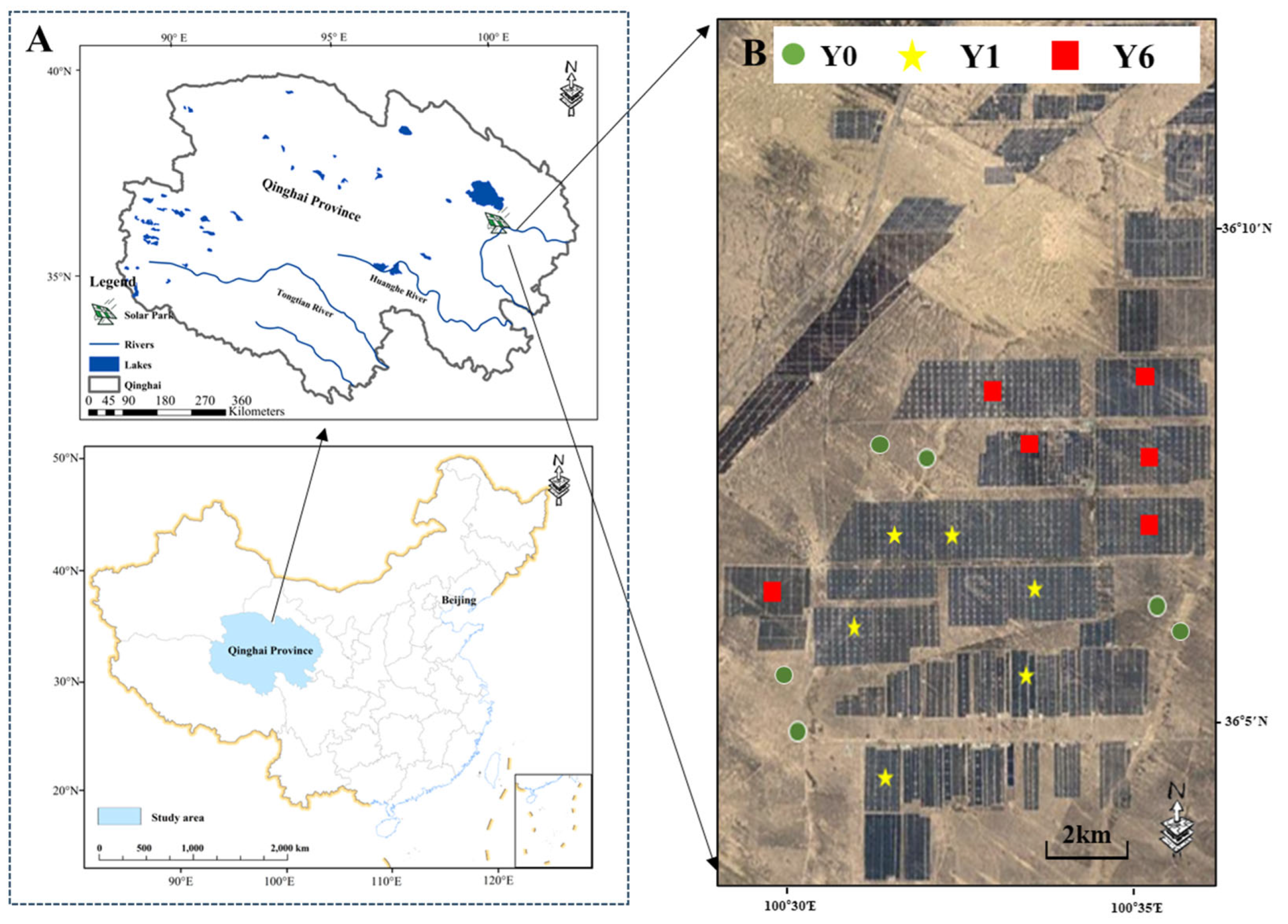
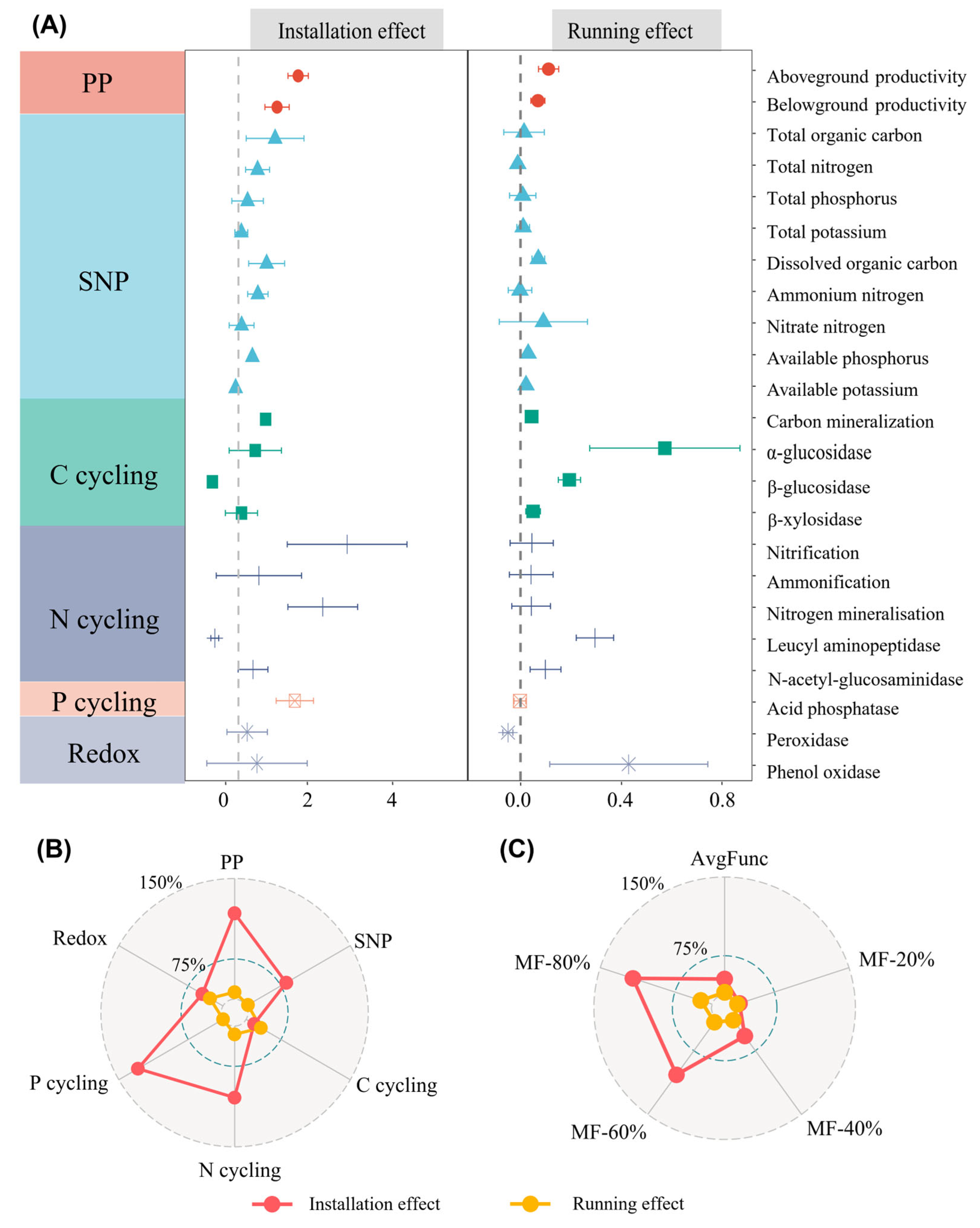
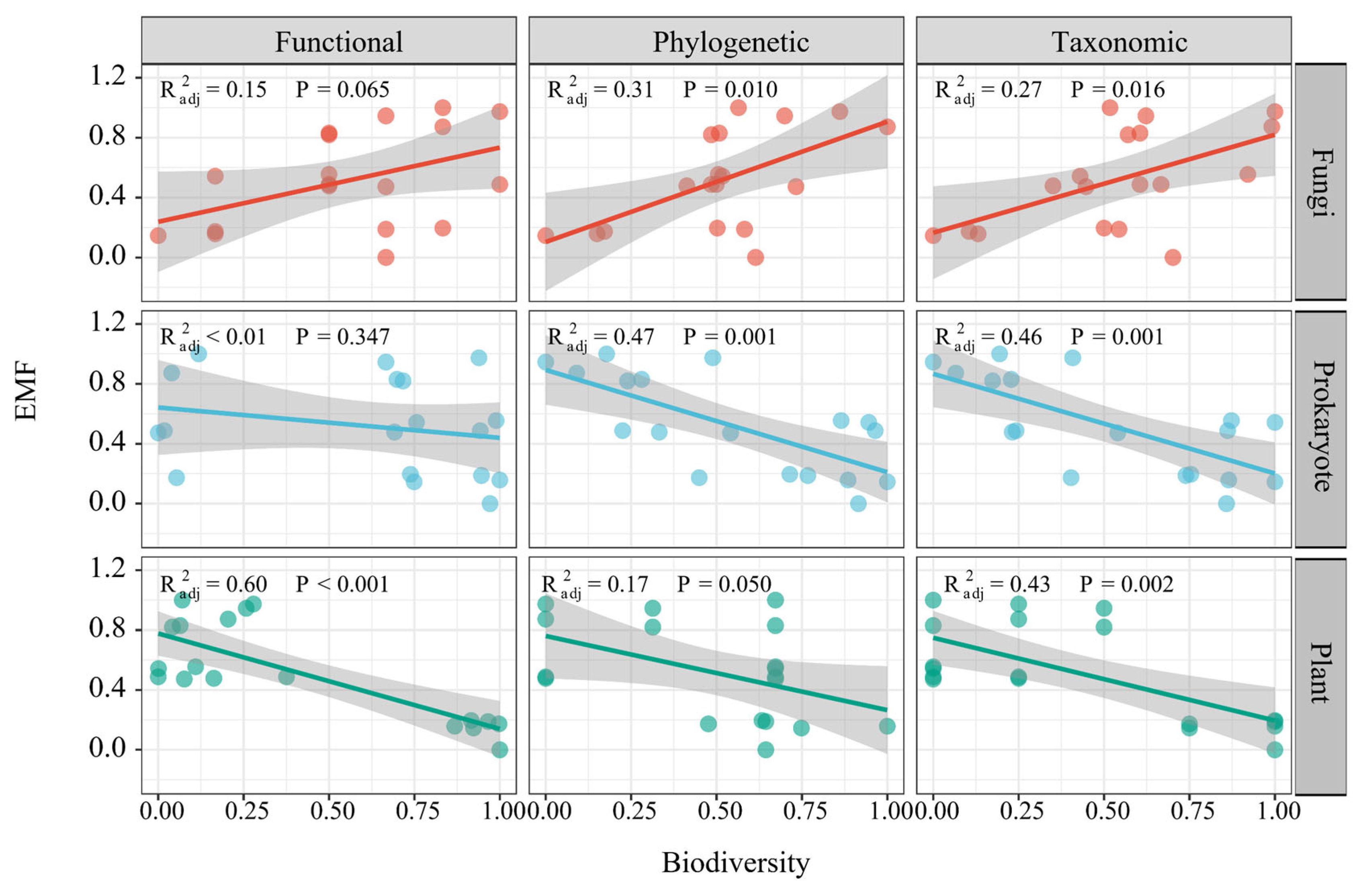
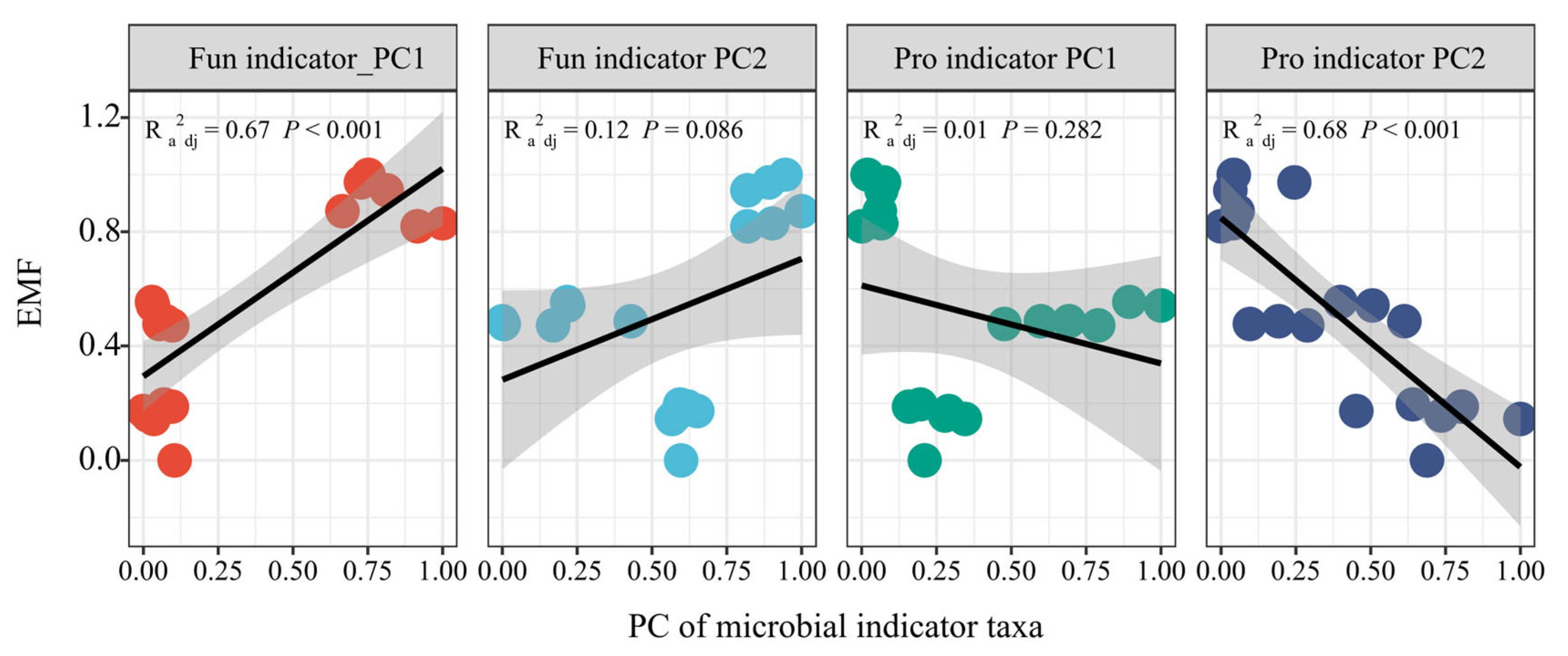
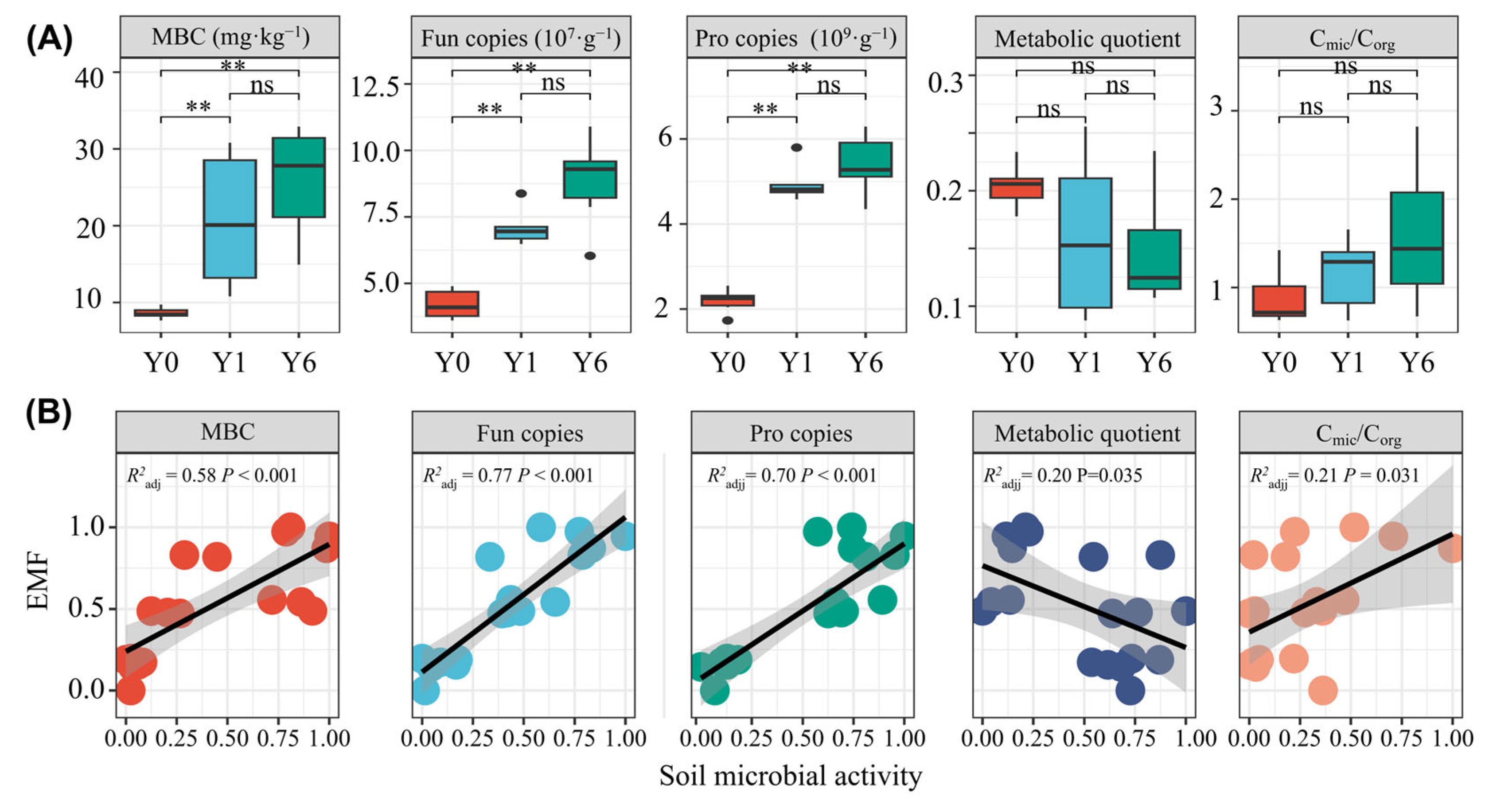
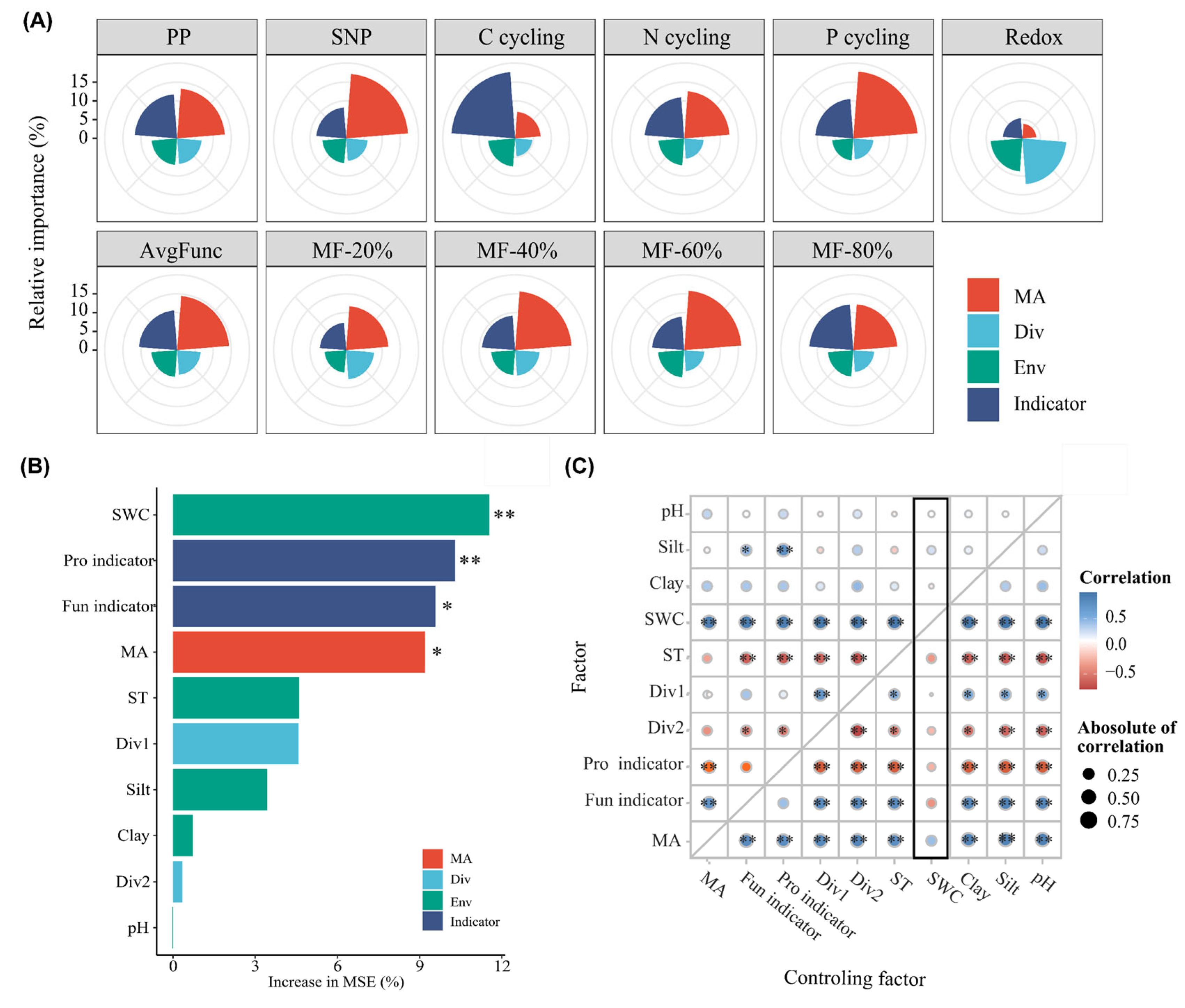
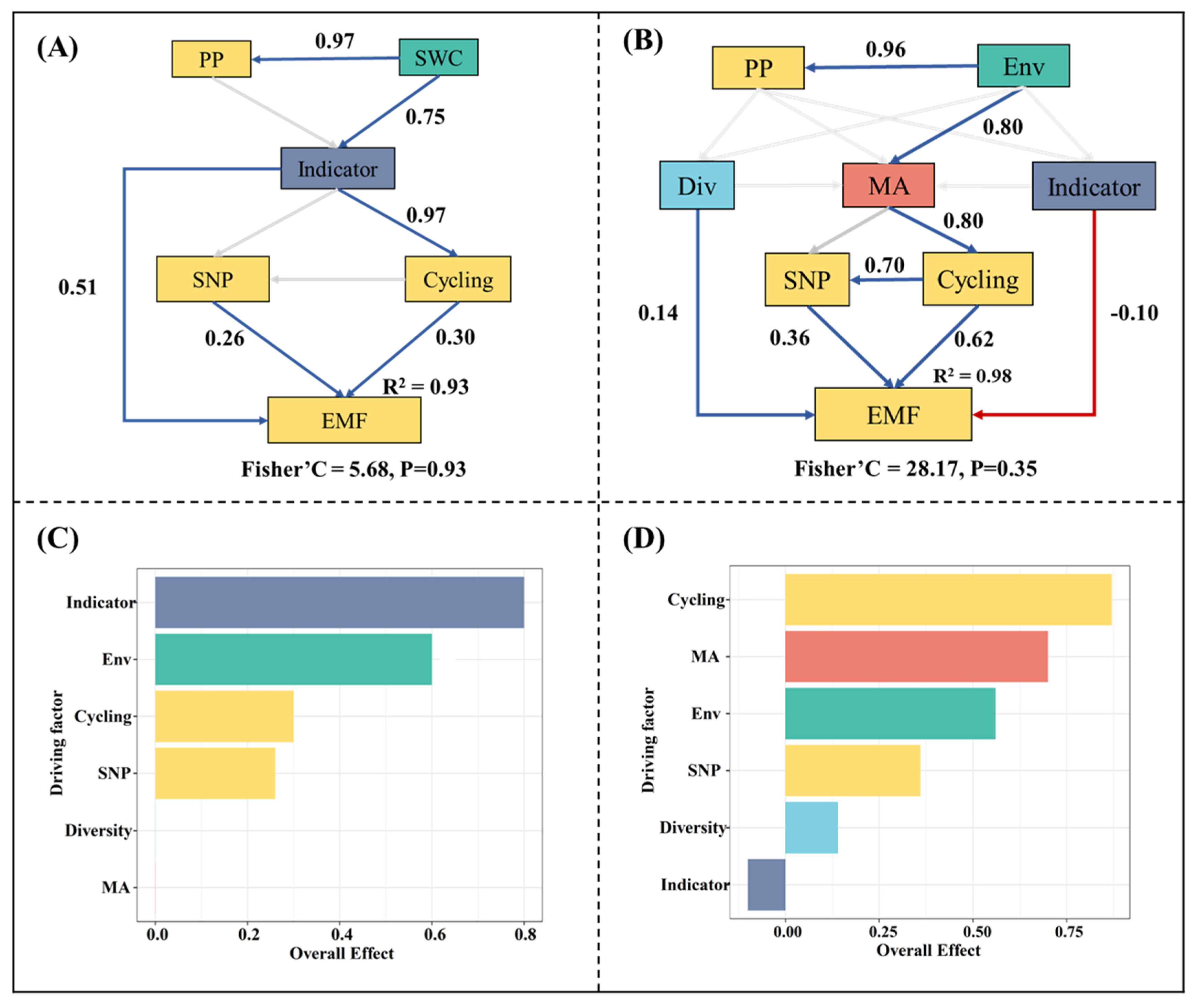
| Category | Group | Driving Factor |
|---|---|---|
| Biotic factor | Microbial activity (MA) | Gene copy number of fungi |
| Gene copy number of prokaryotes | ||
| Microbial biomass carbon | ||
| Microbial metabolic quotient | ||
| Ratio of microbial carbon to organic carbon | ||
| Diversity (Div) | Taxonomic diversity of plants | |
| Taxonomic diversity of fungi | ||
| Taxonomic diversity of prokaryotes | ||
| Phylogenetic diversity of plants | ||
| Phylogenetic diversity of fungi | ||
| Phylogenetic diversity of prokaryotes | ||
| Functional diversity of plants | ||
| Functional diversity of fungi | ||
| Functional diversity of prokaryotes | ||
| Indicator taxa (Indicator) | Indicator taxa of fungi | |
| Indicator taxa of prokaryotes | ||
| Abiotic factor | Environmental factor (Env) | Evaporation |
| Soil temperature | ||
| Soil water content | ||
| Soil pH | ||
| Clay | ||
| Silt | ||
| Sand |
Disclaimer/Publisher’s Note: The statements, opinions and data contained in all publications are solely those of the individual author(s) and contributor(s) and not of MDPI and/or the editor(s). MDPI and/or the editor(s) disclaim responsibility for any injury to people or property resulting from any ideas, methods, instructions or products referred to in the content. |
© 2025 by the authors. Licensee MDPI, Basel, Switzerland. This article is an open access article distributed under the terms and conditions of the Creative Commons Attribution (CC BY) license (https://creativecommons.org/licenses/by/4.0/).
Share and Cite
Liu, Y.; Ding, C.; Wang, T.; Su, D.; Li, Z.; Feng, C.; Quan, Z. Ecosystem Multifunctionality Regulated by Soil Microbial Activity and Indicator Taxa Versus Biodiversity for Industrial Solar Facilities on the Qinghai–Tibet Plateau. Microorganisms 2025, 13, 1464. https://doi.org/10.3390/microorganisms13071464
Liu Y, Ding C, Wang T, Su D, Li Z, Feng C, Quan Z. Ecosystem Multifunctionality Regulated by Soil Microbial Activity and Indicator Taxa Versus Biodiversity for Industrial Solar Facilities on the Qinghai–Tibet Plateau. Microorganisms. 2025; 13(7):1464. https://doi.org/10.3390/microorganisms13071464
Chicago/Turabian StyleLiu, Yu, Chengxiang Ding, Tiemei Wang, Derong Su, Zhuoqing Li, Chaoyang Feng, and Zhanjun Quan. 2025. "Ecosystem Multifunctionality Regulated by Soil Microbial Activity and Indicator Taxa Versus Biodiversity for Industrial Solar Facilities on the Qinghai–Tibet Plateau" Microorganisms 13, no. 7: 1464. https://doi.org/10.3390/microorganisms13071464
APA StyleLiu, Y., Ding, C., Wang, T., Su, D., Li, Z., Feng, C., & Quan, Z. (2025). Ecosystem Multifunctionality Regulated by Soil Microbial Activity and Indicator Taxa Versus Biodiversity for Industrial Solar Facilities on the Qinghai–Tibet Plateau. Microorganisms, 13(7), 1464. https://doi.org/10.3390/microorganisms13071464






